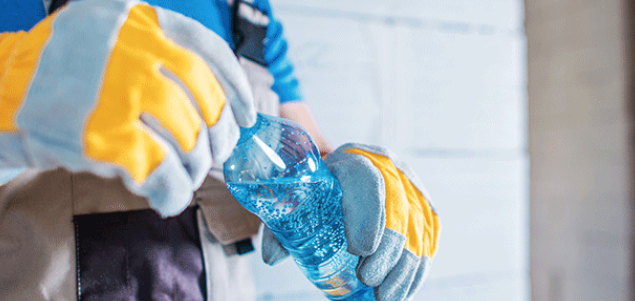Hard hats, harnesses, face shields, goggles, hearing protection, respiratory gear—you make all the right moves when it comes to protecting your employees from external dangers, but what about internal dangers? Appropriate hydration is essential to preventing mental and physical fatigue, both of which are leading contributors to workplace accidents. Before employees go on shift, it’s important to make sure they are protected on the inside, too.
Water is great for helping the bloodstream recover from dehydration and is essential for everyday processes in the body. However, water alone cannot replenish the fluids and electrolytes lost through perspiration, nor the carbohydrates burned during hard work. Without these replenishments, the body can’t be as productive or precise in carrying out the tasks at hand, productivity wanes and the potential for accidents and injuries increases.
Therefore, it is critical to not only educate your employees about proper hydration, but also provide them with a hydration program to help them maintain healthy fluid levels and replenish what is lost during a hard day’s work. Here are some tips for success.
Focus on hydration in toolbox talks. Educating workers about hydration is as important as education on safety protocols and equipment use. Hydration, much like PPE, is a critical component of health and safety in the workplace year-round. Proper hydration throughout a shift will not only replenish what’s lost during hard work, but also help the body function optimally, prevent muscle cramps and keep employees alert and feeling good. Dehydration can make employees more at-risk for accidents, injuries and heat stress.
Include hydration standards in your written safety plan. Until recently, many safety plans overlooked hydration. As employers recognize the potential productivity gains and accident reductions resulting from a well-hydrated workforce, hydration standards are becoming a welcome addition to safety plans.
Hydration standard best practices should include a fluid replacement plan and drinking to thirst. When experiencing thirst, the body is already entering into dehydration. Thirst is a signal to replace fluids. The previous recommendation was one bottle of water per hour. However, fluid replacement plans need to account for additional factors like sun exposure, temperature, humidity, job tasks and level of PPE (e.g., fire-resistant clothing). Employers should ensure that workers have enough beverages available to replace fluids throughout their shifts.
Look at hydration as an investment in safety, productivity and morale. If employees must provide their own hydration, they’re less likely to adhere to the workplace hydration strategy. Make an investment in the continued safety of your workforce by providing the hydration needed to follow their fluid replacement plan. Make it easily accessible! If employees can walk to a cooler and grab a bottle when they need it, they will.
Analyze the bottom-line value of having a hydrated workforce. Think about the high cost of heat stress cases: OSHA penalties if a case results in an accident or injury, the potential costs of temporary workers and the negative impact on productivity and morale. Investing in hydration is no different from investing in protective headgear or harnesses. Hydration is another tool to keep employees safe on the job.
Know and understand your workforce. Even with a hydration plan in place, it remains critical to observe your workforce. If an employee acts differently from their usual patterns—slurred speech, irritable, lethargy, loss of appetite or mood swings—check on them, because their symptoms may indicate dehydration. The better you know your employees, the easier it will be to spot heat stress or dehydration symptoms.
Choose the right hydration. When you choose hydration for your workers, ask the same questions you would when selecting any other PPE, and choose quality hydration that is built to get the job done. Look for a natural, clean and clear product. Natural ingredients are easy on the stomach and are easier for the body to process than artificial ingredients. Simply check the label: Are all the ingredients natural? Are artificial sweeteners used? Does it contain dyes? If a product has the potential to stain your uniform, it’s probably going to stain your insides, too! Before investing in a product, make sure you have confidence in its quality and performance.
Protecting your workers is top of mind for you every single day. Give yourself the peace of mind of knowing you’ve protected them not only on the outside, but also from the inside out. The rewards will come back to you in the form of increased productivity, accident and injury prevention and boosted employee morale.
Article from – https://ohsonline.com



Comments are closed